
A decomposing body in car trunk, a ‘house of horrors’ and a religious group: What we know about Georgia murder
Five adults and a teenager were arrested on murder charges after the decomposing body of a female was discovered in the trunk of a car outside a Korean spa called Jeju Sauna in Duluth, Georgia. Investigators say that the victim had been starved and beaten for weeks and was in such bad condition that detectives initially had a difficult time determining the victim’s gender. Police say that the shocking discovery was made after one of the suspects, who was in hospital, asked a family member to collect something from the car when the grim discovery was made and the police were called. The discovery sparked a homicide investigation and detectives believe the victim moved to the US from South Korea over the summer to join a religious group called Soldiers of Christ. Here’s what we know. How was the body discovered? Investigators claim that Eric Hyun, 26, parked a silver Jaguar sedan outside of Jeju Sauna on 12 September before calling a family member to pick him up, police said. That family member then drove the 26-year-old to an Atlanta area hospital “due to unrelated injuries.” While he was in the hospital, Mr Hyun asked his relative to retrieve something for him from the car; that’s when the family member noticed “what appeared to be a deceased body in the trunk,” prompting the relative to call 911. This 911 report launched an investigation. Gwinnett County detectives then searched a home “associated with” Mr Hyun in Lawrenceville, allegedly finding evidence to suggest the basement of the home was where the crime took place, officials wrote. Police are now investigating the death as a homicide. Who are the suspects? Six people have been arrested and charged in connection to the death, police said on Thursday 14 September. Five adults — Eric Hyun, 26, Juoonhyum Lee, 22, Joonho Lee, 26, Hyunji Lee, 25, and Gawon Lee, 26 — have been arrested and charged with felony murder, false imprisonment, tampering with evidence and concealing a death, according to police. A 15-year-old minor was also arrested. Police added that the suspects “referred to themselves as belonging to ‘Soldiers of Christ.’” “Detectives believe all suspects are currently in custody, and there are no outstanding individuals,” officials added. Who was the victim? Due to the body’s decomposed state, investigators couldn’t initially identify the victim’s gender, police previously told WSB-TV. Police have said the victim is a female, but her identity has not been released yet as her next of kin lives outside of the US and have not yet been officially notified. The victim, investigators discovered, seemed to have moved from South Korea to the US over the summer for the “purpose of joining a religious organization.” She appeared to have been starved and beaten for weeks, police added. As the victim weighed only 70 pounds at the time of her death, the Medical Examiner’s Office believes malnourishment could be a contributing factor, officials wrote. Still, her exact cause of death is being investigated. Police previously said they believed that the victim could have known or been related to the suspects. Where was the body found? Although the body was found in the parking lot outside of Jeju Sauna, the business appears to be completely unrelated to the incident. The owner of Jeju Sauna told Fox 5 about the surveillance video; the footage captured a man pulling up to the spa in the Jaguar alongside a Mercedes on Tuesday morning. The owner added that the man looked in the Jaguar trunk before getting into the Mercedes and taking off. Later that night, the owner told the outlet, the video showed the Mercedes returning — just as police arrived at the scene. There was a foul odour from the trunk, the owner added, suggesting that the body had been there for a while. Jeju Sauna said in a statement that the incident had “absolutely nothing to do with” the business, but merely happened in the parking lot outside it. “The safety and well-being of our customers have always been our utmost priority,” the statement said. “We are fully cooperating with local law enforcement authorities who are currently investigating the matter. We are confident that they will bring those responsible to justice swiftly.” Read More Five people arrested on murder charges after body found in trunk of car linked to ‘house of horrors’ Alex Murdaugh’s financial trial date set as he appears in court for first time since murder conviction – live Danelo Cavalcante planned carjacking to flee to Canada before capture - latest updates
1970-01-01 08:00

Alex Murdaugh’s financial trial date set as he appears in court for first time since murder conviction – live
A smiling Alex Murdaugh appeared in court on Thursday to face a string of financial fraud charges – in what marks his first court appearance since he was sentenced to life in prison for the murders of his wife Maggie and son Paul. The convicted killer attended a status conference before Judge Clifton Newman in Beaufort County on Thursday morning where his financial crimes trial date was set for 27 November. The case will focus on the millions of dollars he stole from the family of his dead housekeeper Gloria Satterfield – part of the 101 state charges over his alleged financial crimes. Two former friends and alleged co-conspirators in his financial crimes also appeared in court on Thursday – former Palmetto State Bank CEO Russell Laffitte and former attorney Cory Fleming The court appearance comes as the deadline is looming for the South Carolina Attorney General’s Office to respond to a bombshell motion filed by Murdaugh’s attorneys last week in which they demanded a new trial and accused Colleton County Clerk of Court Rebecca Hill of pressuring jurors to return a guilty verdict. The AG’s office had 10 days to respond to this motion – giving them until Friday. Read More Smiling Alex Murdaugh appears in court in shackles as trial date set in financial fraud case An Alex Murdaugh juror gained infamy with a dozen eggs. Now she’s at the centre of his bid for a new trial Will Alex Murdaugh be granted a new trial? Legal expert weighs in Alex Murdaugh accuses ‘fame seeking’ court clerk of jury tampering at his murder trial
1970-01-01 08:00
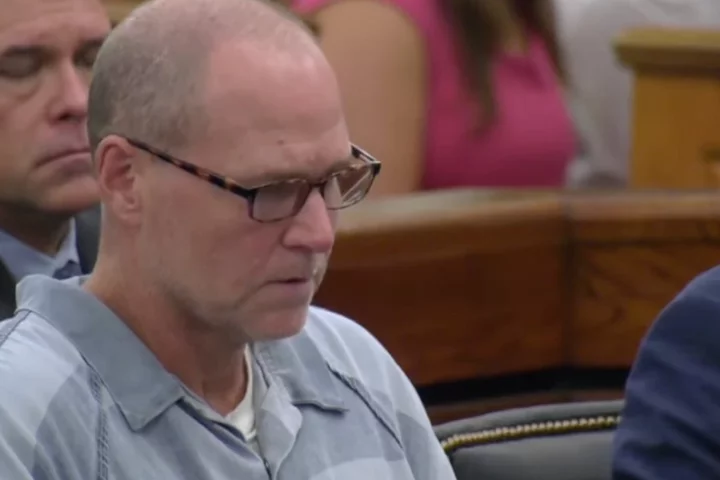
Alex Murdaugh’s longtime friend and alleged accomplice is sentenced to 10 years for financial fraud crimes
Former attorney Corey Fleming was sentenced to 10 years in prison on charges that he conspired with his longtime friend Alex Murdaugh to steal millions of dollars from trusting clients. Fleming previously pleaded guilty to the financial fraud charges that stem from Murdaugh’s alleged scheme to steal money from the estate of his dead housekeeper Gloria Satterfield. Satterfield died in a fall on the Murdaugh property in 2018. He was also involved in stealing money from the family of Hakeem Pinckney – a man whose family Murdaugh represented after he was killed in a car crash in 2009. While Fleming knew Murdaugh was asking him to do wrong, he previously said he didn’t realise the depth of his old friend’s depravity. The sentencing was handed down on the same day Fleming’s longtime friend Murdaugh appeared in court for his own hearing on financial fraud charges for the first time since he was sentenced to life in prison in the murders of of his wife Maggie and son Paul. Judge Clifton Newman set a trial date for 27 November. On 15 August, Fleming pleaded guilty to federal conspiracy charges and was sentenced to nearly four years (46 months) in federal prison. He is housed at the Charleston County jail awaiting a prison assignment. On 23 August, he pleaded guilty to all state charges. Judge Newman scheduled Fleming’s sentencing for today in Beaufort so that the court could hear from friends and family members, as well as victims. At the hearing on Thursday, prosecutor Creighton Waters urged the judge to not be fooled by Fleming’s claims that he was “recruited” by Murdaugh into stealing from the families of Satterfield and Pinckney. Mr Waters argued that Fleming, who was an attorney at the time, was hired to represent the families but then “behind the scenes colluded with the defendant”. “What Mr Fleming wants the court to believe is… that he was tricked and fooled by Mr Murdaugh like everyone else,” Mr Waters said. The prosecutor then pointed to the fake Forge scheme in which Murdaugh allegedly set up a firm called Forge - a fake company with the name of a real one, which was used to siphon off money from clients. Murduagh and Fleming are accused of securing payouts from insurance companies in Satterfield’s case and then sending nearly $4m in stolen money to the fake company. “It was a shakedown, plain and simple,” Mr Waters said of Fleming and Murdaugh’s treatment of the Satterfield family. At the hearing on Thursday, several people addressed the court on behalf of the victims. Tony Satterfield, the son of Gloria Satterfield, told the court, “I still forgive Mr Fleming.” Satterfield’s sister also addressed the court and said that the family forgives Fleming. “Gloria did not die in vain as her case brought out other corruption and dishonest misdeeds being done to others,” she said, adding that it brought corruption “to light”. Attorney Eric Bland, who represents the Satterfield family, spoke at the hearing and said the law profession is “stained” by Fleming’s crimes. Fleming surrendered his license to practice law in both Georgia and South Carolina, saying he dishonored the profession. “The profession we love has been stained,” he said. “Mr Fleming knew exactly what he was doing. He is a plaintiff lawyer... it is impossible.” He said the debacle involving Murdaugh, Fleming and Laffitte, has “stained our state.” Mr Bland said the judge and court will hear how Fleming is a good guy, but that “good guys can still do criminal things.” “I’ve been suing other lawyers for 30 years. Never seen a case where the lawyers took every single dollar. But that’s what Fleming and Murdaugh did. Every single dollar.” Mr Bland also went over several examples of violations and irregularities in how Fleming handled and filed the Satterfield case to show the depth of the conspiracy and the criminal behaviour. He says Fleming and Murdaugh sat on the $4.3m settlements knowing that Gloria Satterfield’s son Brian, a vulnerable adult, was being put out on the street because his mom’s trailer was being foreclosed on. Mr Bland called it “blatant thievery”. Fleming is the second Murdaugh associate ordered to prison since investigators began scrutinising every aspect of Murdaugh’s life in June 2021 after his wife and son were shot to death at their South Carolina home. Russell Laffitte, who was convicted of federal charges in November, appeared for a status conference on Thursday in his state case. One of his attorneys, South Carolina State Rep Todd Rutherford, asked the judge to delay a trial until the fall of 2024. Judge Newman said that he would make a ruling at a later date. Last month, Laffitte was sentenced to seven years in prison after pleading guilty to helping Murdaugh steal money from settlements for clients after vehicle wrecks or work injuries. Laffitte is appealing his conviction and sentence. Read More Smiling Alex Murdaugh appears in court in shackles as trial date set in financial fraud case Outrage as South Carolina lawmaker stands to shake hands with convicted killer Alex Murdaugh in court Alex Murdaugh’s friend pleads guilty to helping steal from dead maid’s family
1970-01-01 08:00

Wrongly arrested because of facial recognition: Why new police tech risks serious miscarriages of justice
On 16 February, Porcha Woodruff was helping her children get ready for school when six Detroit police officers arrived at her door. They told her she was under arrest for a January carjacking and robbery. She was so shocked she wondered for a moment if she was being pranked. She was eight months into a difficult pregnancy and partway through a nursing school programme. She did little else besides study and take care of her kids. She certainly wasn’t out stealing cars at gunpoint, she said. “I’m like, ‘What,?’ I opened my door so he could see my stomach. ‘I’m eight months pregnant. You can see two vehicles in the driveway. Why would I carjack?’” she told The Independent. “‘You’ve gotta be wrong. You can’t have the right person.’” Her children cried as she asked officers if the suspect was pregnant and insisted they had mistakenly arrested her. She was put in handcuffs and taken to jail, where she had panic attacks and early contractions. She later learned police identified her as a suspect after running security footage through the department’s facial recognition software, relying on a 2015 mugshot from a past traffic arrest into a photo lineup where the carjacking victim singled out Ms Woodruff as her assailant. The Detroit Police Department eventually dropped the case, but the arrest has deeply shaken Ms Woodruff. “What happened to the questioning? What happened to me speaking to someone?” she said. “What happened to any of the initial steps that I thought were available to a person who was accused of doing something?” The case underscores the growing risks of civil rights violations as police departments and law enforcement agencies across the country increasingly adopt facial-recognition and other mass surveillance technologies, often used as an unreliable shortcut around methodical human police work. Criminal justice advocates and the people targeted by this burgeoning police tech argue these programmes are riddled with the same biases and opaque or nonexistent oversight measures plaguing policing at large. The early results, at least, haven’t been encouraging. At least six people around the US have been falsely arrested using facial ID technology. All of them are Black. These misfires haven’t stopped the technology from proliferating across the country. At least half of federal law enforcement agencies with officers and a quarter of state and local agencies are using it. “We have no idea how often facial recognition is getting it wrong,” Albert Fox Cahn, executive director of the Surveillance Technology Oversight Project (STOP), told The Independent. “When you have facial recognition being used thousands of times, without any accountability for mistakes, it’s inviting injustice,” he added. Nowhere has that injustice been more pronounced than Detroit, a city where Black people have long experienced documented over-policing from law enforcement. Three of the six people mistakenly arrested by facial recognition technology have been in the Motor City, according to the ACLU. This status quo is why Ms Woodruff is suing DPD, claiming among other things that the agency has engaged in “a pattern of racial discrimination” against her and other Black residents “by using facial recognition technology practices proven to misidentify Black citizens at a higher rate than others in violation of the equal protection guaranteed by” the Michigan civil rights statutes. “I definitely believe that situation would’ve gone differently had it been another race, honestly, just my opinion. There was no remorse shown to me and I was pregnant. I pleaded,” she told The Independent. “Being mistaken for something as serious as that crime – carjacking and armed robbery – that could’ve put me in a whole different type of lifestyle,” she added. “I was in school for nursing. Felons cannot become nurses. I could’ve ended up in jail. That could have altered my life tremendously.” The Independent has requested comment from DPD. After Ms Woodruff filed her suit, Detroit police chief James White said in a press conference in August “poor investigative work” led to the false arrest, not facial recognition technology. He claimed that department software gave detectives numerous possible suspects and was only meant to be a “launch” point for further investigation. “What this is, is very, very poor investigative work that led to a number of inappropriate decisions being made along the lines of the investigation, and that’s something this team is committed to not only correcting, having accountability, having transparency with this community, and in building policy immediately to ensure regardless of the tool being used, this never happens,” Mr White said. He added that officers won’t be allowed to use images sourced by facial recognition in lineups, and warrants based on facial ID matches must be reviewed by two captains before being carried out. ‘The lead and the conclusion’ Some aren’t convinced these changes will prevent the excesses of what they see as a fundamentally flawed technology. “The technology is flawed. It’s inaccurate,” Philip Mayor, senior staff attorney at the ACLU of Michigan, told The Independent. “Police repeatedly assured us that it’s being used only as an investigative lead, but what we see here in Detroit time and time again is it is both being used as the lead and the conclusion.” Studies suggest that facial-recognition algorithms, which have been used to capture suspects in high-profile cases like those connected to January 6, also fail to accurately identify Black people and women, driving up inequalities in arrests, because image-training datasets often lack full diversity. However, according to Mr Mayor, police departments make things even worse by failing to do basic training and common-sense investigative work on top of facial recognition tools. He represents Robert Williams, a Detroit man who was mistakenly arrested for a 2020 theft from a high-end Detroit boutique. A security contractor employed by the store worked with the city and state police and flagged Mr Williams’ name using facial recognition tools. How police came to trust that Williams was the right man reveals the sloppiness of how facial ID tech is used in practice, according to the ACLU attorney. After the theft, police searched a database containing both past photos of Mr Williams and his present-day driver’s license. ‘It picks out 486 people who are the most likely perpetrators; not a single one of them is his current driver’s license, even though his current driver’s license is in the database that was searched,’’ Mr Mayor said. “That seems like an obvious exculpatory fact, the kind of thing that would lead you to say if you were actually thinking, this isn’t the right guy.” When these dubious matches are then used to build a line-up, questionable police work attains the gloss of near-fact, and witnesses choose from a group of people who may have no credible tie to a crime that took place but still look something like the person who did. “This is not me,” Mr Williams told police during his investigation, according to The New York Times. “You think all Black men look alike?” The father of two, after asking a local police voluntarily stop using facial recognition technology, sued the DPD in 2021. “This technology is dangerous when it doesn’t work, which is what the cases in Detroit are about. It’s even more dangerous when it does work. It can be used to systematically surveillance when we come and go from every one of the places that are important in our private lives,” the ACLU attorney said. “I don’t think there’s any reason to believe that departments elsewhere right now are not making the same mistakes.” ‘A force multiplier for police racism’ Detroit isn’t the only place grappling with the impacts – and errors – of this technology. In Louisiana, the use of facial recognition technology led to a wrongful arrest of a Georgia man for a string of purse thefts. A man in Baltimore spent nine days in jail after police incorrectly identified him as a match to a suspect who assaulted a bus driver. The Baltimore Police Department ran nearly 800 facial recognition searches last year. Those cases and others have added to a growing list of misidentified suspects in a new era of racial profiling dragnets fuelled by tech that is rapidly outpacing police and lawmakers’ ability to fix it. Facial recognition software often is “a force multiplier for police racism,” worsening racial disparities and amplifying existing biases, according to Mr Cahn. It can spur a vicious cycle. Black and brown people are already arrested at disproportionate rates. These arrests mean they are more likely to enter a database of faces being analyzed and used for police investigations. Then, error-prone facial recognition technology is used to comb these databases, often failing to identify or distinguish between Black and brown people, particularly Black women. “So the algorithms are biased, but that’s just the start, not the end of the injustice,” Mr Cahn says. Such technologies, advocates warn, are embedded in wider mass surveillance programmes that often lack robust public oversight. In New York City, law enforcement agencies relied on facial recognition technology in at least 22,000 cases between 2016 and 2019, according to Amnesty International. New York City’s Police Department spent nearly $3bn growing its surveillance operations and adding new technology between 2007 and 2019, including roughly $400m for the Domain Awareness System, built in partnership with Microsoft to collect footage from tens of thousands of cameras throughout the city, according to an analysis from STOP and the Legal Aid Society. The NYPD has failed to comply with public disclosure requirements about what those contracts – from facial recognition software to drones and license plate readers – actually include, according to the report. Until 2020, that money was listed under “special expenses” in the police budget until passage of the Public Oversight of Surveillance Technology Act. The following year, more than $277m in budget items were listed under that special expenses programme, the report found. “We’ve seen just concerted pushback from police departments against the sort of oversight that every other type of government agency has because they don’t want to be held accountable,” according to Mr Cahn. “If we treated surveillance technology vendors the way we treated other technology vendors, it would be like Theranos – police would be arresting some of these vendors for fraud rather than giving them government contracts,” he added. “But there is no accountability.” On 7 August, 2020, New York City Police Department officers in riot gear launched a six-hour siege outside Derrick Ingram’s Hell’s Kitchen apartment. Mr Ingram – a racial justice organiser who is embroiled in a federal lawsuit against the NYPD – was surrounded by more than 50 officers after he allegedly shouted into an officer’s ear at a protest earlier that summer. Police insisted they had a warrant on assault charges, but couldn’t produce one when Mr Ingram asked them to, according to his suit. The whole encounter, in which the NYPD deployed snipers, drones, helicopters, and police dogs, began with facial recognition technology. “To say that I was terrified is an understatement – I was traumatized, I still am,” Mr Ingram later testified. “I fear deep down in my core that if I opened my door to those officers, my life would be swiftly taken.” To identify Mr Ingram as a potential suspect, NYPD relied on facial recognition software “as a limited investigative tool, comparing a still image from a surveillance video to a pool of lawfully possessed arrest photos,” according to a police statement, adding that “no one has ever been arrested solely on the basis of a computer match.” The software pulls from a massive internal database of mugshots to generate possible matches, according to the department. Civil rights groups and lawmakers criticized the department’s use of facial recognition – initially hailed as a tool to crack down on violence offenders – for being deployed to suppress dissent, and triggering a potentially lethal police encounter at Mr Ingram’s home. As for Ms Woodruff in Detroit, she hopes her experience can show the dangers of relying too heavily on facial recognition technology. “It may be a good tool to use, but you have to do the investigative part of using that, too,” she said. “It’s just like everything else. You have your pieces that you put together to complete a puzzle.” Her life would’ve been a whole lot different, she said, if “someone would’ve just taken the time to say, ‘OK, stop, we’re going to check this out, let me make a phone call.’” Read More Detroit police changing facial-recognition policy after pregnant woman says she was wrongly charged White House science adviser calls for more safeguards against artificial intelligence risks How a Drake concert put NYPD’s ‘arsenal’ of surveillance technologies under the spotlight
1970-01-01 08:00

Hunter Biden indicted on federal gun charges following special counsel probe
Federal prosecutors have indicted President Joe Biden’s son Hunter Biden on three charges stemming from allegedly false statements in the purchase of a firearm following a special counsel investigation. The indictment – the first ever against a sitting president’s son – follows a failed plea agreement on tax and gun charges that collapsed in July under scrutiny from a federal judge. Charges announced on 14 September follow a multi-year investigation from David Weiss, who was appointed by Donald Trump and remained as US attorney for Delaware under the current administration in an apparent effort to avoid the appearance of a conflict of interest. Mr Weiss, whose investigation preceded the Biden administration and Biden campaign, was appointed as special counsel in August. Hunter Biden was set to plead guilty to misdemeanour tax charges and enter a diversion agreement related to a felony gun charge in July, but the agreement appeared to hit a snag during a federal court hearing, and the judge presiding over the case ultimately rejected the arrangement. Congressional Republicans, meanwhile, continue to investigate the younger Biden and prepare an impeachment inquiry against the president, fuelled by GOP allegations that he was involved with and profited from his son’s business dealings. House Republicans have not provided any evidence that the president was influenced by or profited from such dealings while in office. A Delaware grand jury’s indictment charges Hunter Biden with illegally owning a gun as a drug user, and for allegedly lying on a form when he bought the firearm. The charges are expected to draw right-wing outrage and fuel Republican campaigns against the Biden family, as the frontrunner for the 2024 Republican nomination for president faces four criminal indictments spanning dozens of charges, including for crimes allegedly committed while in office. The day before the indictment was announced, attorneys for Hunter Biden sued a former Trump-era White House official accused of launching a “sustained, unhinged and obsessed campaign” against him and the Biden family, including hacking the alleged contents of a laptop that were central to political campaigns surrounding the 2020 presidential election, federal investigations and Republican-led congressional probes. This is a developing story Read More Why Trump’s DOJ could help Biden with House Republicans’ impeachment inquiry Hunter Biden sues former Trump aide tied to laptop hack Why do Republicans want to impeach Joe Biden?
1970-01-01 08:00

Alex Murdaugh appears in court for first time since murder trial sentencing for financial crimes hearing
Alex Murdaugh appeared before a judge in a South Carolina courtroom on Thursday for the first time since he was hauled away after being sentenced to life in prison for the brutal murders of his wife Maggie and son Paul earlier this year. The disgraced attorney was shackled and handcuffed but smiled as he entered the courtroom in Beaufort County and shuffled to the defence table wearing a bright orange jumpsuit. He once again stands before Judge Clifton Newman, who oversaw his murder trial back in March, but now faces a slew of financial fraud charges. Judge Newman is expected to set a date for Murdaugh to stand trial on charges for stealing from the estate of his dead housekeeper Gloria Satterfield and from his family friend Jordan Jinks. Murdaugh is accused of stealing insurance payments meant for the family of his housekeeper, Satterfield, who died after a fall at the Murdaugh family property in 2018. Former Palmetto State Bank CEO Russell Laffitte and former attorney Cory Fleming – both former friends of Murdaugh’s and alleged co-conspirators in his financial crimes – are also due in court on the same day. Fleming is expected to be sentenced on Thursday after pleading guilty to 23 counts, which included conspiring and working with Murdaugh to steal from clients and friends. Laffitte – who was convicted of federal charges in November – is also appearing for a status conference in his state case. Murdaugh is facing more than 100 state and federal charges over his alleged financial crimes – many of which he admitted to on the witness stand at his murder trial. The hearing on Thursday will focus on the state charges. A court hearing on the federal charges is scheduled for 21 September. Murdaugh previously agreed to plead guilty to federal charges he stole millions of dollars from clients, according to court records. The court appearance comes just over a week after Murdaugh’s defence attorneys filed a bombshell motion requesting a new trial based on allegations of inappropriate behaviour by Colleton County Clerk of Court Rebecca Hill. Read More Alex Murdaugh to face court for first time since murder trial sentencing as jury tampering update looms – live Another twist in the Alex Murdaugh double murder case. Did the clerk tamper with the jury? Alex Murdaugh’s friend pleads guilty to helping steal from dead maid’s family
1970-01-01 08:00

Trump will be tried separately from Powell and Chesebro in Georgia election interference case, judge rules
Donald Trump and 16 other co-defendants in the Georgia election interference case will be tried separately from lawyers Kenneth Chesebro and Sidney Powell, the judge in the case has ruled. “Defendants Chesebro and Powell will join each other at trial, however, the other 17 defendants are severed from these two. Additional severances may follow. All pretrial deadlines will proceed as scheduled without a stay of proceedings,” Judge Scott McAfee at the Superior Court of Fulton County wrote in a ruling issued on Thursday. The trial for Mr Chesebro and Ms Powell is set to go ahead on 23 October. The move comes after Mr Chesebro and Ms Powell invoked their right to a speedy trial, the judge noted. Their motions to severance their cases from each other were denied but the court found that “severing the remaining 17 co-defendants is simply a procedural and logistical inevitability,” leading to the motions to sever from Mr Chesebro and Ms Powell being “granted in part”. The judge wrote that joint trials are “generally favoured” because they “promote judicial efficiency and prevent inconsistent verdicts”. He added that any defendant who doesn’t waive their right to a speedy trial before 23 October, as Mr Trump has, will “immediately” be added to that trial. Fulton County District Attorney Fani Willis attempted to get all 19 defendants in the case, including the former president, to be tried together, citing the “enormous strain on the judicial resources” separate trials would create. But Judge McAfee wrote in his order that “the precarious ability of the Court to safeguard each defendant’s due process rights and preparation ensure adequate pretrial preparation on the current accelerated track weights heavily, if not decisively, in favor of severance”. More follows...
1970-01-01 08:00
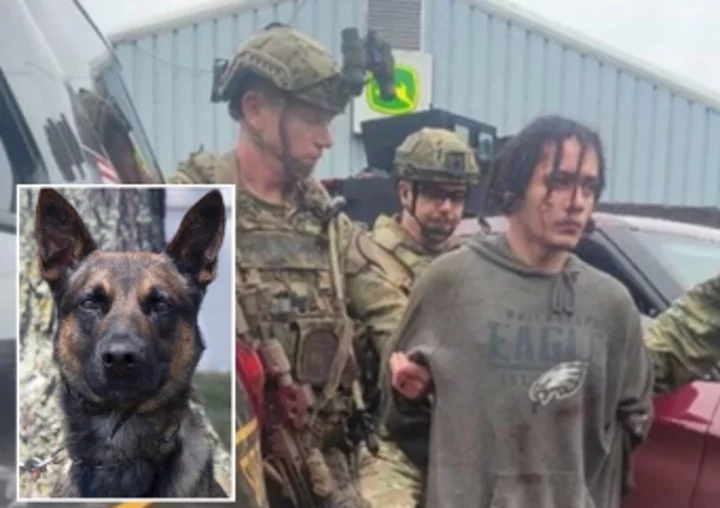
Hundreds of police officers hunted for Danelo Cavalcante for two weeks. A dog secured his capture
As escaped murder convict Danelo Cavalcante was escorted out of the woods of a Pennsylvania town on Wednesday morning, his face bore the mark left by the four-legged hero who subdued him. Calvalcante was finally taken back into custody after a 14-day multi-agency manhunt that spanned more than 25 miles. For nearly two weeks, Cavalcante eluded hundreds of SWAT, FBI, state, federal and local enforcement officers in full combat gear, as well as tracking dogs, and police on horseback and on aircraft. It was a US Border Patrol’s tactical unit (BORTAC) that finally made the capture shortly after 8am. Dozens of agents in the special operations unit celebrated the major development with a victory photo next to a defeated, bloodied and handcuffed Cavalcante. The key participant in the imminent capture, a K-9 who surprised Cavalcante and tackled him to the ground, also posed front row next to its handler for the photo. A Border Patrol spokesperson told The Independent that the K-9 behind the heroic efforts is a four-year-old Belgian Malinois named Yoda. Pennsylvania State Police Lt Col George Bivens said that Cavalcante began to crawl through heavy underbrush as border patrol agents closed in on him. Yoda then set out to subdue Cavalcante and left the escaped killer with a gnarly scalp wound that bled onto his face. “K9s play a very important role, not only for tracking but also in a circumstance like this, safely capturing someone,” Mr Bivens said. “Far better than having a patrol dog subdue the individual and then have to use lethal force. Our intention is always to use other means.” Mr Bivens said the K9s that participated in the search are typically used to simply detain suspects without causing additional injuries. According to the Border Patrol’s website, the dogs are “trained in human detection, tracking and the physical apprehension of violent subjects is singularly suited for this need.” Border Patrol said that it worked together with state police and other local and federal agencies to corner Cavalcante and secure his arrest. Agents from Buffalo, Detroit, Washington and Vermont and Border Patrol’s Special Operations Group in El Paso, Texas, participated in the capture. “Today’s actions are the latest demonstration of how our agents and officers bring incredible capability, additional interagency communications technology, and dedication to keep our communities safe,” a spokesperson said. “Most importantly, all those involved in the search were able to return home safe following the end to this manhunt.” BORTAC agents are deployed to specialised missions across the country and are described as “highly skilled at tracking humans in all terrain and in all environments.” Cavalcante’s escape from a Pennsylvania prison on 31 August ensued a frantic manhunt for the convicted killer in the vast wooded terrains of Chester County. Residents gripped by fear followed pleas by police to secure their homes, as three school districts in the area and a large botanical garden were forced. Law enforcement faced criticism for Cavalcante’s success in eluding officers and sneaking past the search perimeter. The initial four-square-mile search area had to be expanded to 10 square miles and then dropped altogether after Cavalcante managed to steal a vehicle and drive more than 25 miles from his initial hiding spot. Then on Monday night, Cavalcante broke into a garage in South Coventry Township and stole a .22 rifle with a scope and a flashlight on it. The homeowner opened fire on Cavalcante with his pistol but the fugitive was not injured. Authorities blamed the vast wooded area and the weather for their failure to capture Cavalcante sooner, noting that no perimeter could be secured completely. Retired Las Vegas Police Lt Randy Sutton agreed that the biggest challenges law enforcement faced were weather and containment-related. Aircraft with thermal technology had been flying over Cavalcante’s hiding area, but high temperatures likely prevented human signals from being detected. “It is absolutely impossible to contain a subject within a perimeter if it has not been diminished to an area where the manpower could be completely surrounded,” Mr Sutton, founder of the nonprofit The Wounded Blue, told The Independent. “It is not unusual for individuals to escape from perimeters, and that is why there is flexibility [in] changing those parameters. Law enforcement did just that and is what eventually led to the capture of the suspect.” He added: “The suspect could’ve been captured earlier had additional resources in the terms of manpower and technology been employed but once again, there is no full-proof method when it comes to a manhunt. “This individual could’ve [held] up for many more days or even weeks, had he located an unoccupied structure and remained there.” The first possible sign of Cavalcante that alerted searchers shortly after midnight Tuesday was a burglar alarm. Law enforcement personnel investigated it and did not find Cavalcante. But the alarm attracted nearby search teams to the area and around 1am, a Drug Enforcement Administration plane with a thermal imaging camera picked up a heat signal that searchers on the ground began to track and encircle. Storms moving in with rain and lightning forced the plane to leave the area while search teams stayed put and tried to secure a perimeter around where the heat signal had been to prevent Cavalcante from slipping away once again. Later in the morning, the plane returned along with more search teams. Border patrol agents then moved in on Cavalcante in a wooded area, about a half-mile away from where the burglary alarm went off. Cavalcante was wearing an Eagles hoodie and what appeared to be his prison pants when he was apprehended. Officers cleaned his bloodied face and proceeded to cut off his clothing before he was escorted inside a tactical vehicle. “Folks, whoever had their Eagles’ hoodie stolen,” Gov Josh Shapiro joked at a press conference after the arrest. “If you could let us know, I’ll do my best to get you one of those new Kelly Green ones.” Cavalcante was transported to PSP’s Avondale barracks, where he will be interviewed. He is then expected to be moved to a state-run prison facility. The capture likely brought ease to members of the suburban community, especially the family of Cavalcante’s murder victim Deborah Brandao. Prosecutors said during his trial last month that Cavalcante stabbed Brandao roughly 40 times in April 2021 to prevent her from telling American authorities that he was wanted for murder in Brazil. “Our nightmare is finally over and the good guys won,” Chester County District Attorney Deborah Ryan said. “We never lost faith that this capture would take place and knew it was just a matter of time.” Read More Danelo Cavalcante capture details revealed as escaped prisoner treated for dog bite: Live updates Pennsylvania fugitive Danelo Cavalcante is captured hiding under logs in shed two weeks after prison escape Pennsylvania police take group photo with captured fugitive Danelo Cavalcante
1970-01-01 08:00
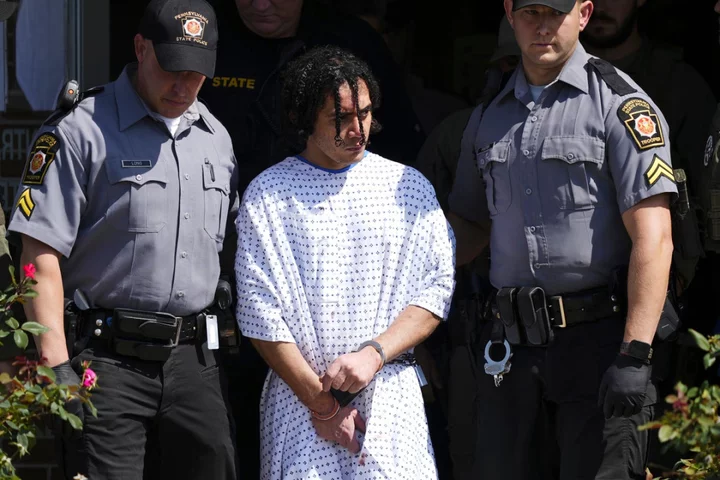
Danelo Cavalcante evaded capture for two weeks on run by burying his faeces and surviving on watermelon
Escaped prisoner Danelo Cavalcante has revealed that he managed to evade capture for two weeks on the run by burying his own faeces and surviving on watermelon. Cavalcante escaped Chester County Prison in Pennsylvania back on 31 August after he was handed a life sentence for murdering his former girlfriend. It was not until almost two weeks later – on the morning of 13 September – that the escaped prisoner was finally back in handcuffs, after he was captured by a tactical team and police K-9 in a wooded area. Since his capture, investigators have now revealed that Cavalcante complied with their questions and told them various details about his time on the run from the police. Supervisory Deputy US Marshall Robert Clark, who conducted the manhunt that eventually led to his capture, spoke to NewsNation’s Chris Cuomo about the aftermath of his arrest. Mr Clark said that the fugitive was “brutally honest” about his two weeks evading capture from law enforcement and the measures he went to to survive and stay hidden. Various investigators, from US Marshalls, PA State police to county police, all wanted to interview him, but were unsure what to expect, he said. “We took a Brazilian law enforcement interpreter, and we asked if he wanted to talk and he did,” Mr Clark told NewsNation, saying that by Cavalcante agreeing, they were able to fill in the gaps in their investigation. According to Mr Clark, the fugitive said that, within the first three days, he didn’t move far from Chester County Prison. After that, Cavalcante said that he ate watermelon he stole from a farm, drank water from a stream and hid within dense thickets where, unless someone stepped on him, he would be able to remain hidden from sight. To cover his tracks, he would hide his faeces under leaves. There were several close calls with search teams, the fugitive also allegedly admitted. “He did say on three occasions law enforcement officers did almost step on him. They were about seven to eight yards away from him,” Mr Clark said. “We believe he was brutally honest. He described things such as hiding his faecal matter under leaves so that we couldn’t detect them.” The officers even asked how Cavalcante managed to change his appearance by becoming clean-shaven while on the run, questioning whether someone had helped him. His answer was simple: the backpack he was pictured with, held a single razor. The investigators and Mr Clark found Cavalcante’s story “credible” and “candid,” as he went into detail about how he moved out of the first perimeter by scoping out an area he could escape across. Cavalcante told officials that he noticed more and more of a law enforcement presence and became aware of aerial assets and helicopters. He apparently also told investigators about the vehicle he stole on 10 September, that police found abandoned in a field behind a barn 15 miles outside of Phoenixville. He also spoke about the stolen firearm, which he obtained after breaking into a resident’s garage, Mr Clark said. Had he not been captured – with the help of a K-9 that bit him on the top of his head – Cavalcante planned to flee the country. “He intended to carjack somebody in the community and head north to Canada, or either or try to get back to Puerto Rico. He said he was going to do that in the next 24 hours. And that was the reason he kept that firearm. He knew he needed a weapon in order to get a vehicle,” Mr Clark said. Cavalcante also told law enforcement that Mexico was on the list of possible places he may have fled to, according to Steve Keeley from Fox 29. “Cavalcante said his endgame was to carjack someone in next day because he noticed increasing aerial search helicopters & airplanes… He only moved at night, no days,” Mr Keeley said on X. Mr Keeley’s source also matched what Mr Clark said about the fugitive conducting his own surveillance during his escape, both of the perimeter around Longwood Gardens and on the house where he stole the firearm from. Mr Clark said his US Marshall colleagues described Cavalcante during the interview as “calm, cool, [and] didn’t have any attitude to him”. Cavalcante was finally caught when Pennsylvania officials closed in on him on Wednesday morning. He was crawling through heavy underbush trying to get away, but was stopped by a four-year-old K-9 called Yoda, who was dispatched to grab hold of him by biting him on his head. After he was captured, a large group of officers took a group photo with the criminal now back in handcuffs, something they have since come under fire for. Cavalcante was serving a life sentence in prison for fatally stabbing his ex-girlfiend Deborah Brandao. He is also wanted for a murder he committed in 2017 in Brazil. Read More Captured killer Danelo Cavalcante reveals how he survived on run as police under fire for group photo: Live Hundreds of police officers hunted for Danelo Cavalcante for two weeks. A dog secured his capture Pennsylvania fugitive Danelo Cavalcante is captured hiding under logs in shed two weeks after prison escape
1970-01-01 08:00
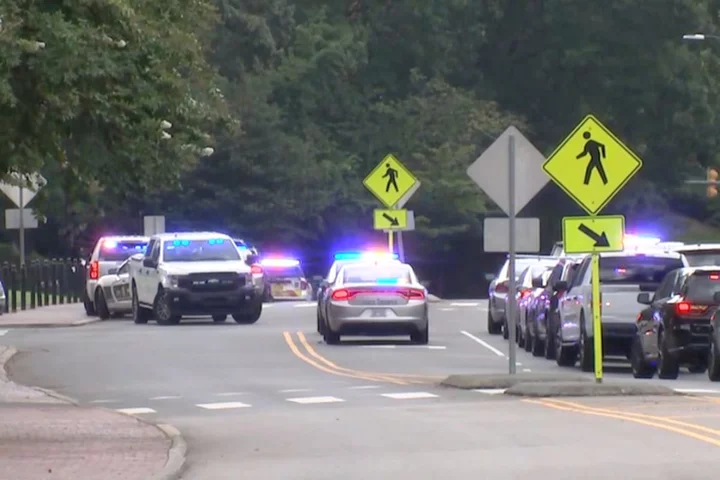
UNC lockdown updates: Horror as armed person waves gun at Chapel Hill bagel shop weeks after campus shooting
The University of North Carolina’s Chapel Hill campus was put on lockdown for the second time in two weeks after an armed person waved a gun inside a bagel shop. An alert was sent out at 12.54pm ET on Wednesday, asking students and staff to “go inside now” and to “avoid windows” because of the threat “on or near campus”. An all-clear alert was put out at 2.10pm. An official told The Daily Tar Heel that the incident came when the suspect allegedly brandished a gun at Alpine Bagel over an employment-related conflict. No shots were fired and police said that suspect Mickel Deonte Harris, 27, was arrested at around 2.45pm just north of the campus. This marks the second terrifying incident at the school in just over two weeks. On 28 August, the campus was on lockdown for hours amid reports of an “armed and dangerous person”. That person was identified as Tailei Qi, a 34-year-old graduate student who allegedly shot and killed Zijie Yan, an associate professor in the Department of Applied Physical Sciences. Read More UNC campus on lockdown over ‘armed and dangerous person’ two weeks after shooting Students criticize the University of North Carolina's response to an active shooter emergency Audio reveals 911 caller in University of North Carolina shooting immediately identified a suspect Who was UNC Chapel Hill shooting victim Zijie Yan?
1970-01-01 08:00
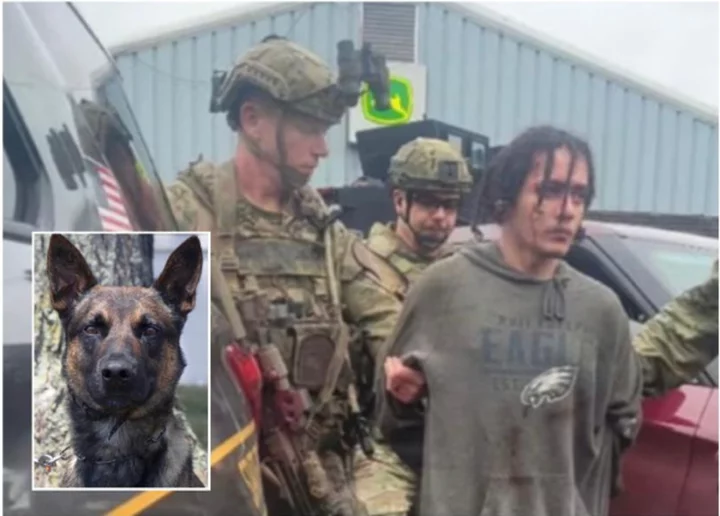
Danelo Cavalcante capture details emerge as Border Patrol dog Yoda credited with securing arrest: Live
Escaped prisoner Danelo Cavalcante has been captured after almost two weeks on the run. The convicted killer was tracked down using thermal imaging technology before a Border Patrol tactical team surrounded him at around 8am on Wednesday morning. Law enforcement officials had the “element of suprise” over Cavalcante, police said in a press conference. Pennsylvania State Police Lt Col George Bivens said that Cavalcante began to crawl through heavy underbrush as agents closed in on him. Yoda, a four-year-old Belgium Malinois, then set out to subdue Cavalcante and left the escaped killer with a gnarly scalp wound that bled onto his face. Cavalcante escaped Chester County Prison on 31 August – days after he was sentenced to life for fatally stabbing his ex-girlfriend Deborah Brandao. He is also wanted for a 2017 murder in Brazil. His escape kicked off a desperate manhunt as he repeatedly evaded authorities. On Tuesday, officials revealed that he had broken into a garage and stolen a firearm. In an interview with The New York Times, Cavalcante’s mother Iracema Cavalcante defended her son’s actions, saying that he killed Brandao after she reportedly threatened to tell American authorities he was being sought by Brazilian police. Read More Where has Danelo Cavalcante been spotted since his Pennsylvania jailbreak? Fugitive Danelo Cavalcante’s mother defends his murders and says ‘everyone is lying about him’ Dog the Bounty Hunter may join search for Danelo Cavalcante
1970-01-01 08:00
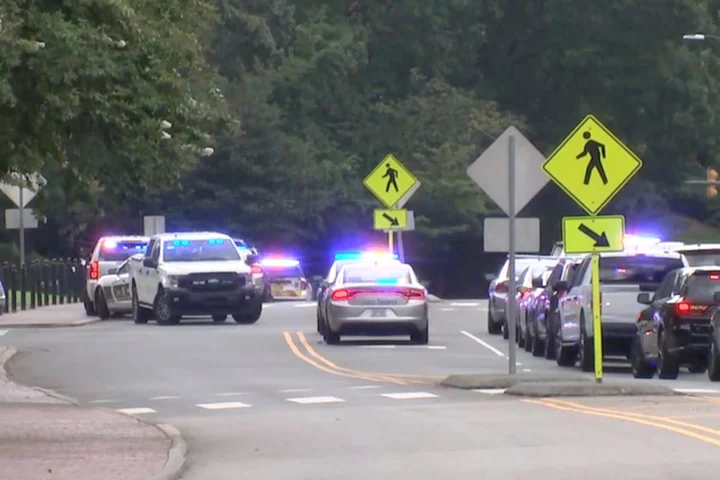
UNC lockdown - live: Suspect named after ‘armed’ person triggered alert on Chapel Hill campus
The University of North Carolina’s Chapel Hill campus was put on lockdown for the second time in two weeks after reports of an “armed and dangerous person”. An alert was sent out at 12.54pm ET, asking students and staff to “go inside now” and to “avoid windows” because of the threat “on or near campus”. The all-clear was put out at 2.10pm. No other official details have been provided on the alert. However, local TV station WRAL reported that police were on the lookout for a suspect involved in an incident at Alpine Bagel at the UNC Student Union after a person was seen with a firearm. The news station reported that one person was eventually arrested just north of the campus. This marks the second terrifying incident at the school in just over two weeks. On 28 August, the campus was on lockdown for hours amid reports of an “armed and dangerous person”. That person was identified as Tailei Qi, a 34-year-old graduate student who allegedly shot and killed Zijie Yan, an associate professor in the Department of Applied Physical Sciences. Read More UNC campus on lockdown over ‘armed and dangerous person’ two weeks after shooting
1970-01-01 08:00
